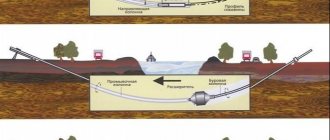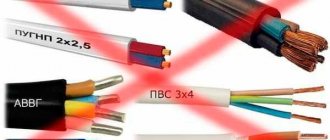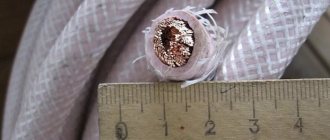Is it possible to lay several cables in one pipe?
When installing electrical wiring in steel pipes, is it possible to lay two or more lines in one pipe at once to different points (sockets, light bulbs, or two sockets and two light bulbs, for example)?
It is possible, but only power lines are laid in one pipe, and lighting lines in another. There are requirements for this in the PUE, clause 2.1.15. In steel and other mechanically strong pipes, hoses, boxes, trays and closed channels of building structures, joint laying of wires and cables is allowed (with the exception of mutually redundant ones): 1. All circuits of one unit. 2. Power and control circuits of several machines, panels, panels, consoles, etc., connected by the technological process. 3. Circuits powering a complex lamp. 4. Circuits of several groups of one type of lighting (working or emergency) with a total number of wires in the pipe no more than eight. 5. Lighting circuits up to 42 V with circuits above 42 V, provided that the wires of circuits up to 42 V are enclosed in a separate insulating pipe. 2.1.16. In one pipe, sleeve, box, bundle, closed channel of a building structure or on one tray, the joint installation of mutually redundant circuits, working and emergency lighting circuits, as well as circuits up to 42 V with circuits above 42 V is prohibited (for an exception, see 2.1.15, clause 5 and 6.1.16, clause 1). The laying of these chains is allowed only in different compartments of boxes and trays that have solid longitudinal partitions with a fire resistance limit of at least 0.25 hours made of fireproof material. It is allowed to lay emergency (evacuation) and working lighting circuits on different outer sides of the profile (channel, angle, etc.).
Hello, is it allowed to lay a riser supplying an apartment in a multi-apartment residential building in one ready-made wall channel and then in one pipe together with the staircase lighting cable?
Source
Installation of electrical wiring in corrugated open method
Installation of open electrical wiring in a wooden house
Installation of corrugated pipes includes several stages. Algorithm for installing electrical wiring in a corrugated open method:
- To fix the hose, special clips made of high-quality plastic are used. They come in different sizes; the choice will depend on the diameter of the pipes used.
- Clips are attached to surfaces at intervals of 30-40 cm. This is done using dowel screws or self-tapping screws. The choice of parts depends on the material from which the surface is made, for example, wood, concrete, brick, etc.
- For reliable fixation, the corrugation is pressed into the clip until a characteristic click appears. If the clips were selected correctly, the possibility of spontaneous loss is excluded.
At the design stage, when laying out a schematic wiring path, you need to take into account the following important points:
- The maximum and permissible radius of rotation of the corrugation is 90 degrees. The smoother the angle, the better.
- Turns should not be located close to each other; the optimal distance between them is 4-5 meters. If this is not possible, for safety reasons the wiring is additionally equipped with a junction box.
- The maximum length of an individual section is 25 meters, the permissible number of turns is 4.
How many cables can be laid in one pipe?
An automated group metering unit (AGZU) is installed at the well cluster, as well as a modular automation unit included in the AGZU delivery package (BMA AGZU). Our design organization lays cable lines between AGZU and BMA AGZU in two TGGD produced by JSC "DKS": in one TGGD there is a bundle of power cables, in the second TGGD there is a bundle of control cables. The number and cross-section of cables between the AGZU and the BMA AGZU are selected according to the factory diagram for the AGZU.
The installation method was chosen in accordance with paragraph 2.1.15 of the PUE: “In steel and other mechanically strong pipes, hoses, boxes, trays and closed channels of building structures, joint installation of wires and cables is allowed (with the exception of mutually redundant ones):
The customer received a request regarding the compliance of this method of laying PUE cables:
We believe that clause 2.1.1 does not apply to cables laid in the ground in a pipe, but applies only to cables laid directly in the ground (without a pipe, tray, etc.). Clarification is required on the joint laying of power cables in a bundle in one flexible corrugated double-walled pipe (TGGD) in the ground in a trench for compliance with PUE standards.
1. Clause 2.1.1 applies to all cable lines, including those laid in pipes.
2. PUE Rules for electrical installations. Edition 6 is not a standardization document; the provisions of this document are largely outdated, so they can be applied to the extent that does not contradict the requirements of the standardization documents.
Explanation by A. Shalygin, head of the ICC MIEE, in the magazine “News of Electrical Engineering” No. 5 for 2013 (see information at: https://news.elteh.ru/aq/arch.php3?aq=83), regarding the given question reads:
“Chapters of the PUE, such as 1.3, 2.1 and 2.3 are hopelessly outdated. The standards laid down in the 6th edition of the PUE corresponded to the realities of the seventies of the last century. PUEs contain very limited, but interrelated data. Thus, clause 2.3.86 of the PUE corresponds to table. 1.3.36 PUE, which simply does not contain data for shorter distances. At that time, it was believed that laying cables at a distance of less than 100 mm was impractical due to a significant reduction in the permissible current load. According to table. 1.3.36 PUE with six cables in a trench we obtain a correction factor of 0.75.
In modern conditions, with increased building density and an increase in the cost of land allocation, such solutions have in some cases become economically unfeasible. On January 1, 2013, GOST R 50571.5.52-2011 Low-voltage electrical installations came into force. Part 5-52. Selection and installation of electrical equipment. Electrical wiring. This standard provides comprehensive information on the selection of wires and cables. In particular, it contains all the necessary correction factors when laying up to twenty cables in a trench, including touching cables .” (See table B.52.18 - note .)
At the same time, GOST R 50571.5.52-2011 is a regulatory reference document in SP 76.13330.2016 Electrical devices (the document is included in the List of documents in the field of standardization, as a result of which, on a voluntary basis, compliance with the requirements of Federal Law of December 30, 2009 No. 384 is ensured -FZ 'Technical regulations on the safety of buildings and structures').
Source
Calculator for calculating the permissible number of cables in a corrugated pipe
When laying electrical wiring and other networks in houses or apartments, polymer or metal corrugation has recently become very active. It is believed that such additional insulation dramatically increases the resistance of wires and cables to external negative influences of various natures, and reduces the risk of wiring fires in emergency situations.
Calculator for calculating the permissible number of cables in a corrugated pipe
The wiring enclosed in corrugated pipes looks really advantageous. But this approach significantly adds trouble to installers. At least for the reasons that it is necessary to cut deeper and wider fines, and even in larger quantities. Especially in areas near distribution boards, where many cables are laid in parallel. Therefore, there are temptations to place as many wires as possible in one corrugation. But under no circumstances should you do this! How do you know how much you can? A calculator for calculating the permissible number of cables in a corrugated pipe will help you.
Working with the calculator is not difficult, but nevertheless a few explanations will be given below.
What is corrugation
Installation of cables in corrugated cables
Corrugated cables, despite their simple design, are considered one of the most useful and sought-after inventions of mankind. Visually, it is a pipe with a ribbed surface, which simultaneously gives it rigidity and flexibility. Corrugated pipes are made from various materials, the most popular being metal, aluminum, and plastic pipes.
Corrugation comes in different diameters, the indicators range from 10 mm to 2 m. This product has a wide range of applications.
Calculator for calculating the permissible number of cables in a corrugated pipe
Brief explanations on the calculation
The corrugation tightly packed with wires is also an inconvenience during installation. And insufficient heat dissipation, and possible mutual interference. Therefore, it is generally accepted that for normal operation of the wiring, the cross-sectional area of all cables or wires stretched in the pipe (taking into account their insulation) should be no more than 35% of the cross-sectional area of the internal channel of the corrugation. This is what the calculation is based on.
It happens that the calculator shows the final value equal to zero. This means that even for a single cable this corrugation diameter is too small, and it is necessary to purchase a pipe one size larger.
Which cables to choose for home wiring
This is a whole science, replete with nuances, ignoring which is a very dangerous matter. Poor quality wires and cables that do not meet operating conditions often cause very serious consequences. Which cable should be used for electrical wiring in an apartment or house - read in a special publication on our portal.
Source
Is it allowed to lay cables together in one corrugated pipe?
Dmitry I am laying a cable over a suspended ceiling from room to room using a VVG-ng 4x3 cable for sockets and a VVGng 1.5x3 cable for lighting, a length of 20 m. Is it permissible to carry out electrical installation of these cables together in one corrugation with a diameter of 25 mm?
Answer: It is allowed to lay the cable together in one corrugated pipe for group outlet lines with group lighting lines. But the most successful and safe solution would be to lay the cable separately, in a separate corrugated pipe. If the cable is damaged during operation, you will need to replace the damaged group cable line, that is, remove the old cable from the corrugated pipe and tighten a new cable. Since there will be a cable in this corrugated pipe, pulling a new cable line will be difficult and unsafe. There is a possibility of damage to the cable insulation when pulling the cable into a corrugated pipe.
After completing all electrical installation work, you need to carry out a set of electrical measurements, namely: 1. Visual inspection 2. Measuring the presence of a circuit between grounded installations and elements of a grounded installation. 3. Measurement of coordination of the parameters of the “phase-zero” circuit with the characteristics of protection devices and the continuity of protective conductors. 4. Measurement of insulation resistance of wires, cables and windings of electrical machines. 5. Measurement and testing of automatic circuit breakers controlled by differential current (RCD). If you cannot carry out electrical measurements yourself, then use the services of specialists from a mobile electrical laboratory.
PUE-6 2.1.15 In steel and other mechanically strong pipes, hoses, boxes, trays and closed channels of building structures, joint laying of wires and cables is allowed (with the exception of mutually redundant ones): 1. All circuits of one unit. 2. Power and control circuits of several machines, panels, panels, consoles, etc., connected by the technological process. 3. Circuits powering a complex lamp. 4. Circuits of several groups of one type of lighting (working or emergency) with a total number of wires in the pipe no more than eight. 5. Lighting circuits up to 42 V with circuits above 42 V, provided that the wires of circuits up to 42 V are enclosed in a separate insulating pipe.
2.1.16 In one pipe, sleeve, box, bundle, closed channel of a building structure or on one tray, the joint installation of mutually redundant circuits, working and emergency lighting circuits, as well as circuits up to 42 V with circuits above 42 V is prohibited (for an exception, see 2.1 .15, clause 5 and in 6.1.16, clause 1). The laying of these chains is allowed only in different compartments of boxes and trays that have solid longitudinal partitions with a fire resistance limit of at least 0.25 hours made of fireproof material. It is allowed to lay emergency (evacuation) and working lighting circuits on different outer sides of the profile (channel, angle, etc.).
2.1.19 When laying wires and cables in pipes, blind boxes, flexible metal hoses and closed channels, it must be possible to replace wires and cables.
Other and useful information
Source
How to insert a wire into a hose
Correct connection of the string with the wire installed in the corrugation.
It is recommended that two people perform the work. This is due to the algorithm of actions.
- Remove the end of the wire (a kind of cable or string) from the hose and connect it to the cable being installed. A hole is made in the wire winding, a thin wire is pushed through it and securely fixed by twisting.
- The hose is leveled along its entire length, only after this can you begin to wind the cable into the corrugation.
- One worker firmly holds the end of the pipe from which the cable is wound, and the second pulls the wire from the other side. This approach allows the wire to be pushed through efficiently.
- The fully extended wire must be wound to the pipe to prevent the structures from moving relative to each other.
There are common cases when the wire gets stuck inside the corrugation. This is due to the weakening of its tension or the formation of bends. Until the end of the pulling process, it is important to monitor the condition of the hose.










